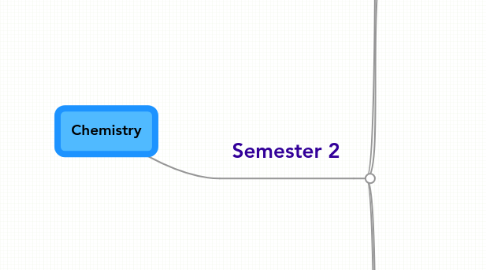
1. Semester 2
1.1. Chapters
1.1.1. Stoichiometry (Chapter 9, Pg 250)
1.1.1.1. Definition
1.1.1.1.1. A Branch of Chemistry where quantities in chemical reactions are calculated.
1.1.1.2. Mole-Mole Calculations
1.1.1.2.1. Examples
1.1.1.3. Mass-Mass Calculations
1.1.1.3.1. Examples
1.1.1.4. 9.1 The Arithmetic of equations
1.1.1.5. 9.2 Chemical Calculations
1.1.2. Chemical Quantities (Chapter 7, Pg 189)
1.1.2.1. 7.1 The mole: A measurement of matter
1.1.2.2. 7.2 Mole-mass and Mole- volume relationships
1.1.2.3. 7.3 Percentage Composition and chemical formulas
1.1.2.3.1. Definition
1.1.2.3.2. Formula
1.1.3. States of Matter (Chapter 10, Pg)
1.1.3.1. 10.1 The nature of gases
1.1.3.2. 10.2 The nature of liquids
1.1.3.3. 10.3 The nature of solids
1.1.3.4. 10.4 Changes of state
1.1.4. The Behavior of Gases (Chapter 12, Pg)
1.1.4.1. 12.1 The properties of gases
1.1.4.2. 12.2 Factors affecting gas pressure
1.1.4.3. 12.3 The gas laws
1.1.4.3.1. Boyles Law
1.1.4.3.2. Charles Law
1.1.4.3.3. Gays Law
1.1.4.4. 12.4 Ideal gases
1.1.4.5. 12.5 Gas molecules: Mixtures and Movements
1.1.5. Reaction Rates and Equilibrium (Chapter 19, Pg 544)
1.1.5.1. Equilibrium
1.1.5.1.1. What can alter Equilibrium?
1.1.5.2. 19.1
1.1.5.3. 19.2
1.1.5.4. 19.3
1.1.6. Acids and Bases (Chapter 20, Pg)
1.1.6.1. 20.1
1.1.6.2. 20.2
1.1.6.3. 20.3
1.1.6.4. 20.4
1.1.7. Neutralization (Chapter 21, Pg)
1.1.7.1. 21.2
1.1.7.2. New node
1.2. Formulas
1.2.1. D = (M/V)
1.2.1.1. Density = (Molar Mass/Volume)
1.2.2. n = (N/Na)
1.2.2.1. Mole = (Representative Particles/Avogadro's Number)
1.2.3. n = (m/M)
1.2.3.1. Mole = (Mass/Molar Mass)
1.2.4. nRT = PV
1.2.4.1. New node
1.2.5. n = (V/Vo)
1.2.5.1. Mole = (Volume/Molar Volume)
1.2.5.2. (P1V1/T1)=(P2V2/T2)
1.2.5.2.1. (Pressure1*Volume1/Temperature1)=(Pressure2*Volume2/Temperature2)
1.2.6. Using the Formulas:
1.2.6.1. n = (N/Na)
1.2.6.1.1. Eg: How many moles of Pb is 9.3*10^15 atoms of Pb? n = (9.3*10^15 / 6.02*10^23) n = 1.5*10^-8 mol
1.2.6.2. D = (M/V)
1.2.6.2.1. Eg:
1.2.6.3. n = (m/M)
1.2.6.3.1. Eg: How many moles of CO2 is 12.3 grams of CO2? n = (12.3g / 44g/mol) n = 0.279mol
1.2.6.4. n = (V/Vo)
1.2.6.4.1. Eg:
1.3. Definitions
1.3.1. Avogadro's Number
1.3.1.1. 6.02*10^23
1.3.1.2. Symbol - Na
1.3.2. Mole
1.3.2.1. The amount of a substance that contains 6.02*10^23 representative particles of a substance.
1.3.2.2. Symbol - n
1.3.3. Gram atomic Mass (gam)
1.3.3.1. The atomic mass of an element expressed in grams.
1.3.4. Gram Formula Mass (gfm)
1.3.4.1. Formula mass of an ionic substance expressed in grams.
1.3.5. Gram Molecular Mass (gmm)
1.3.5.1. The mass of one mole of a molecular compound.
1.3.6. Representative Particle
1.3.6.1. The atoms, molecules, or ions present in a substance.
1.3.6.2. Symbol - N
1.3.7. Molar Mass
1.3.7.1. Mass (in grams) of one mole of a substance.
1.3.7.2. Symbol - M
1.3.8. STP
1.3.8.1. Standard Temperature and Pressure
1.3.9. Molar Volume
1.3.9.1. 22.4 L of gas at STP
1.3.9.2. Symbol - Vo
1.3.10. Percentage Composition
1.3.10.1. The percent by mass of each element in a compound.
1.3.11. Empirical Formula
1.3.11.1. The lowest whole-number ratio of atoms of the elements in a compound.
1.3.12. Molecular Formula
1.3.12.1. Describes the actual number of atoms of each element in a molecule of a compound.
1.3.13. Standard Pressure
1.3.13.1. 101.3 kPa or 1 atm
1.3.14. Molar Road Map
1.3.14.1. A mean of relating mass, numbr of particles, and gaseous volume of a substance.
1.3.15. Standard Temperature
1.3.15.1. 0 oC or 273 K
1.3.16. Stoichiometry
1.3.16.1. A branch of chemistry where quantities in chemical reactions are calculated.
1.3.17. Kinetic Theory
1.3.17.1. New node
1.3.18. Kinetic Energy
1.3.18.1. New node
1.3.19. Amorphous
1.3.19.1. New node
1.3.20. Unit cell
1.3.20.1. New node
1.3.21. Crystal
1.3.21.1. New node
1.3.22. Normal Boiling Point
1.3.22.1. New node
1.3.23. Barometer
1.3.23.1. New node
1.3.24. atmospheric pressure
1.3.24.1. New node
1.3.25. melting point
1.3.25.1. New node
1.3.26. Sublimination
1.3.26.1. New node
1.3.27. Boiling point
1.3.27.1. New node
1.3.28. Allotrope
1.3.28.1. New node
1.3.29. Vapor pressure
1.3.29.1. New node
1.3.30. Evaporation
1.3.30.1. New node
1.3.31. Supercooled Liquid
1.3.31.1. New node
1.3.32. Collision Theory
1.3.32.1. New node
1.3.33. Chemical Equilibrium
1.3.33.1. New node
1.3.34. Le Chateliers Principle
1.3.34.1. New node
1.4. Symbols
1.4.1. Molar Mass
1.4.1.1. M (g/mol)
1.4.2. Mass
1.4.2.1. m (grams)
1.4.3. Mole
1.4.3.1. n (mol)
1.4.4. Density
1.4.4.1. New node
1.4.5. Molar Volume
1.4.5.1. Vo (22.4 L)
1.4.6. Avogadro's Number
1.4.6.1. Na (6.02*10^23)
1.4.7. Volume
1.4.7.1. V (L)
1.4.8. Representative Particles
1.4.8.1. N
1.4.9. Universal Gas
1.4.9.1. R (8.31)
